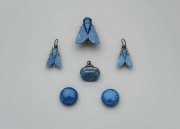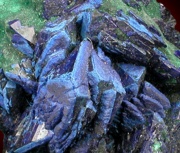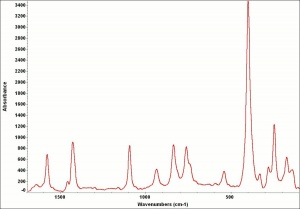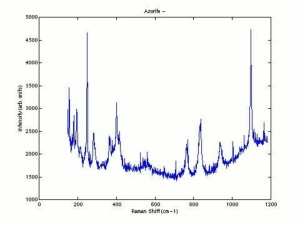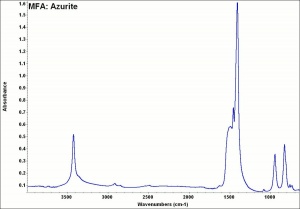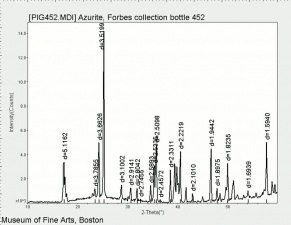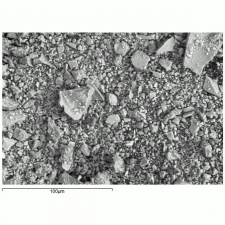Difference between revisions of "Azurite"
| Line 2: | Line 2: | ||
== Description == | == Description == | ||
| − | A deep blue mineral composed of [[basic copper carbonate]] that is naturally found adjacent to the green copper carbonate mineral called [ | + | A deep blue mineral composed of [[basic copper carbonate]] that is naturally found adjacent to the green copper carbonate mineral called [[malachite]]. Azurite and malachite have been used as gemstones and paint pigments since ancient times. They are prepared as pigments by careful selection, grinding, washing, and levigation. Coarsely ground azurite gives a deep blue color while finely ground particles give a lighter more transparent tone. Azurite is lightfast but is sensitive to acids and sulfur fumes. Basic copper carbonate can also be made artificially by coloring [[chalk]] with [[copper sulfate]]. The synthetic pigment, called [[blue verditer]], [[blue bice]], [[Bremen blue]], or ashes blue, tends to have regularly sized particles with rounded edges. Their color is similar to finely ground azurite. |
[[File:azuritedw.jpg|thumb|Azurite]] | [[File:azuritedw.jpg|thumb|Azurite]] | ||
| Line 13: | Line 13: | ||
== Other Properties == | == Other Properties == | ||
| − | Insoluble in water, ethanol. Decomposes in acids with the evolution of carbon dioxide bubbles. Turns black with warm alkalis, hydrogen sulfide or sulfur fumes. | + | Insoluble in [[water]], [[ethanol]]. Decomposes in acids with the evolution of [[carbon dioxide]] bubbles. Turns black with warm alkalis, [[hydrogen sulfide]], or sulfur fumes. |
Strong birefringence. Highly refracting. Pigment particles are irregular in size. Pleochroic from pale blue to deep blue. | Strong birefringence. Highly refracting. Pigment particles are irregular in size. Pleochroic from pale blue to deep blue. | ||
| Line 45: | Line 45: | ||
== Additional Information == | == Additional Information == | ||
| − | ° R. Gettens, and E. West Fitzhugh, "Azurite and Blue Verditer", ''Artists Pigments'', Vol. 2., A. Roy ed. Oxford University Press, Oxford, 1993. ° Pigments Through the Ages: [http://webexhibits.org/pigments/indiv/overview/azurite.html Azurite]° Mineralogy Database: [http://webmineral.com/data/Azurite.shtml Azurite] | + | ° R. Gettens, and E. West Fitzhugh, "Azurite and Blue Verditer", ''Artists Pigments'', Vol. 2., A. Roy ed. Oxford University Press, Oxford, 1993. |
| + | ° Pigments Through the Ages: [http://webexhibits.org/pigments/indiv/overview/azurite.html Azurite]° Mineralogy Database: [http://webmineral.com/data/Azurite.shtml Azurite] | ||
== Comparisons == | == Comparisons == | ||
Revision as of 13:57, 29 July 2013
Description
A deep blue mineral composed of Basic copper carbonate that is naturally found adjacent to the green copper carbonate mineral called Malachite. Azurite and malachite have been used as gemstones and paint pigments since ancient times. They are prepared as pigments by careful selection, grinding, washing, and levigation. Coarsely ground azurite gives a deep blue color while finely ground particles give a lighter more transparent tone. Azurite is lightfast but is sensitive to acids and sulfur fumes. Basic copper carbonate can also be made artificially by coloring Chalk with Copper sulfate. The synthetic pigment, called Blue verditer, Blue bice, Bremen blue, or ashes blue, tends to have regularly sized particles with rounded edges. Their color is similar to finely ground azurite.
Synonyms and Related Terms
basic copper carbonate (natural); Pigment Blue 30; CI 77420; bleu d'Allemagne (Fr.); Bergblau (Deut.); Bergasur; Azurit (Deut.); azurite (Fr., Port.); azzurrite (It.); azzurro della magna (It.); azurita (Esp.); azurium citramarinum; iwagunjo (Jap.); byaku gunjo (Jap.); shi ging (Chin.); mthing (Tibetan); azurro della magna; azoyritis (Gr.); azuriet (Ned.); blue verditer; mountain blue; ashes blue; blue ash; sky blue; German ash; Bremen blue; blue bice; Armenian stone; lapis armenius; chessylite; blue malachite; mineral blue; basic cupric carbonate; copper blue; chessy copper
Other Properties
Insoluble in Water, Ethanol. Decomposes in acids with the evolution of Carbon dioxide bubbles. Turns black with warm alkalis, Hydrogen sulfide, or sulfur fumes.
Strong birefringence. Highly refracting. Pigment particles are irregular in size. Pleochroic from pale blue to deep blue.
Monoclinic tabular crystals. Good cleavage in two directions.
Fracture = conchoidal. Luster = vitreous to dull. Streak = blue.
| Composition | 2CuCO3-Cu(OH)2 |
|---|---|
| CAS | 12069-69-1 |
| Mohs Hardness | 3.5 - 4.0 |
| Density | 3.77-3.80 |
| Refractive Index | 1.730; 1.838; 1.758 |
Hazards and Safety
Skin contact and inhalation may cause irritation or allergic reactions. Chronic exposure may cause anemia.
Additional Information
° R. Gettens, and E. West Fitzhugh, "Azurite and Blue Verditer", Artists Pigments, Vol. 2., A. Roy ed. Oxford University Press, Oxford, 1993. ° Pigments Through the Ages: Azurite° Mineralogy Database: Azurite
Comparisons
Characteristics of Common Blue Pigments
Additional Images
Authority
- Encyclopedia Britannica, http://www.britannica.com Comment: Azurite. Retrieved May 24, 2003, from Encyclopædia Britannica Premium Service.
- R. J. Gettens, G.L. Stout, Painting Materials, A Short Encyclopaedia, Dover Publications, New York, 1966 Comment: p. 95
- G.S.Brady, Materials Handbook, McGraw-Hill Book Co., New York, 1971 Comment: p. 232
- Ralph Mayer, A Dictionary of Art Terms and Techniques, Harper and Row Publishers, New York, 1969 (also 1945 printing)
- C.W.Chesterman, K.E.Lowe, Audubon Society Field Guide to North American Rocks and Minerals, Alfred A. Knopf, New York, 1979
- The Dictionary of Art, Grove's Dictionaries Inc., New York, 1996 Comment: Pigments
- Michael McCann, Artist Beware, Watson-Guptill Publications, New York City, 1979
- R.D. Harley, Artists' Pigments c. 1600-1835, Butterworth Scientific, London, 1982
- Jack Odgen, Jewellery of the Ancient World, Rizzoli International Publications Inc., New York City, 1982
- A.Lucas, J.R.Harris, Ancient Egyptian Materials and Industries, Edward Arnold Publishers Ltd., London, 4th edition, 1962
- Thomas B. Brill, Light Its Interaction with Art and Antiquities, Plenum Press, New York City, 1980
- Book and Paper Group, Paper Conservation Catalog, AIC, 1984, 1989
- The Merck Index, Martha Windholz (ed.), Merck Research Labs, Rahway NJ, 10th edition, 1983 Comment: Entry # 2697
- Wikipedia, the free encyclopedia, at http://www.wikipedia.com Comment: http://en.wikipedia.org/wiki/Azurite (Accessed (Sept 2 2005)
- Art and Architecture Thesaurus Online, http://www.getty.edu/research/tools/vocabulary/aat/, J. Paul Getty Trust, Los Angeles, 2000
